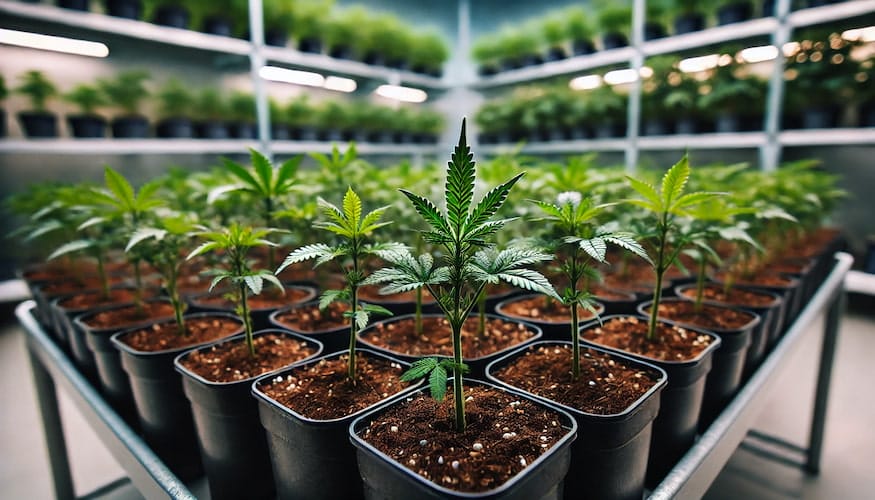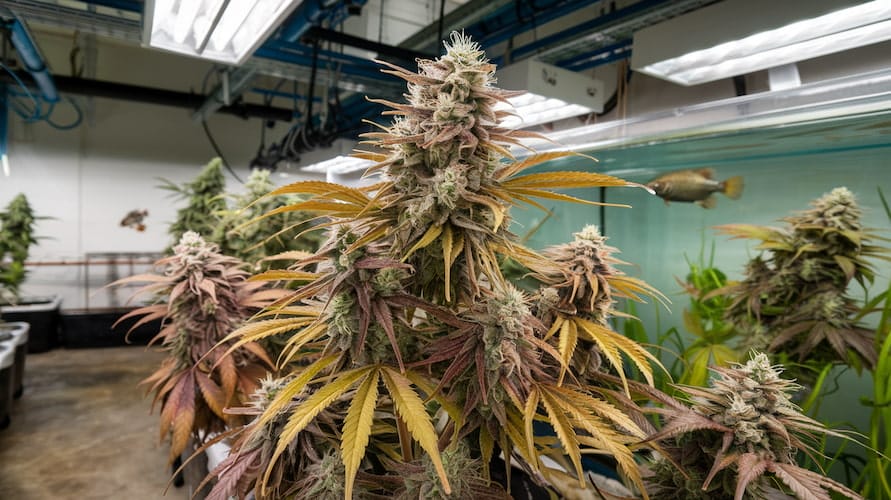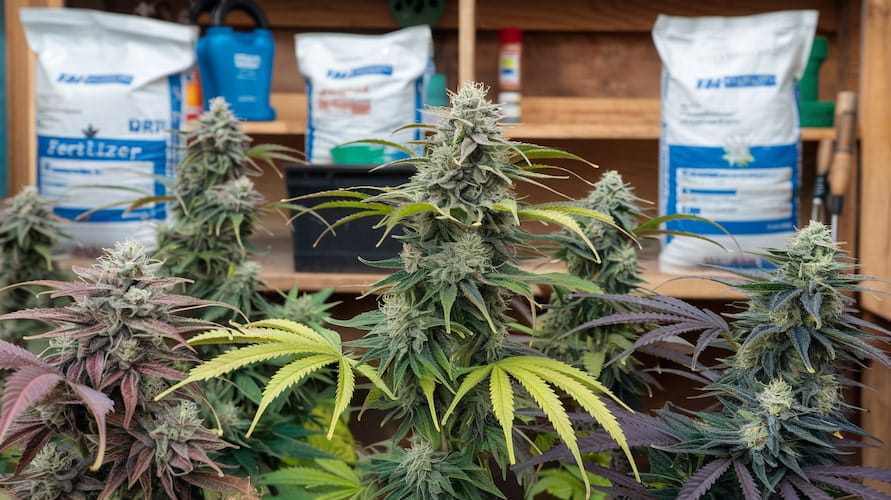I’m James Bean, and if you know anything about SeedsHereNow.com, you know we’ve been the top spot for cannabis seeds since 2010. We’ve been rated the best seed bank eight times, and we work with more than 70 breeders to bring you the best genetics out there. Now, in 2024, we’ve taken the next step […]
Top Dressing Cannabis Plants: The Ultimate Guide
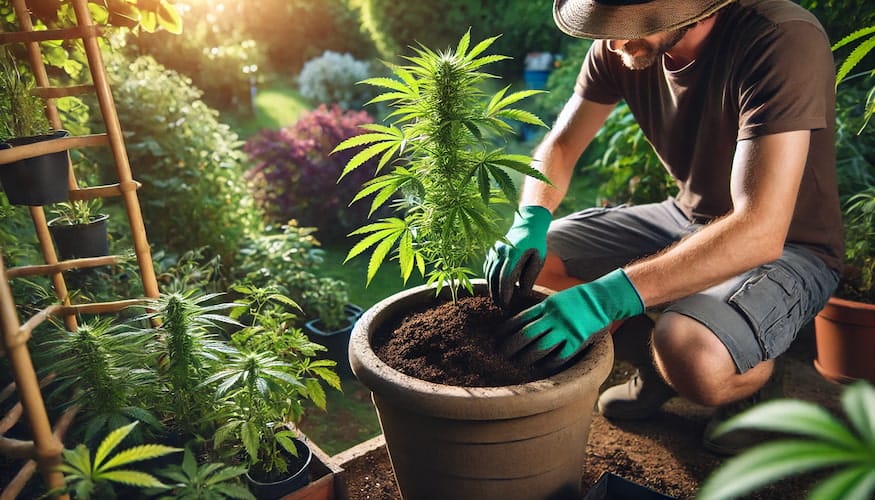
Cannabis cultivation has evolved significantly over the years, with growers continuously seeking methods to enhance plant health and maximize yields. Advanced technologies, synthetic fertilizers, and innovative growing techniques have revolutionized the industry. However, sometimes the old, tried-and-true techniques prove to be the most effective. One such time-honored method gaining renewed popularity is top dressing. This technique, which involves adding a layer of nutrients or amendments to the soil surface, provides a simple yet powerful way to nourish cannabis plants. In this comprehensive guide, we will delve into the intricacies of top dressing cannabis plants, covering everything from its benefits and materials used to step-by-step application and best practices.
Introduction
Top dressing is an age-old agricultural practice that involves adding a layer of organic or inorganic material to the top of the soil. For cannabis growers, this method offers a convenient way to provide plants with essential nutrients without disturbing the root zone. The materials used in top dressing can range from compost and worm castings to specialized nutrient blends designed for cannabis.
Benefits of Top Dressing Cannabis Plants
Top dressing provides several key benefits that contribute to healthier plants and higher yields. Here’s an in-depth look at these benefits:
Enhanced Nutrient Availability
Top dressing ensures a slow and steady release of nutrients. Unlike synthetic fertilizers that can release nutrients too quickly and cause nutrient burn, organic amendments tend to break down gradually, providing a continuous supply of essential nutrients. This steady nutrient availability supports sustained plant growth and development throughout the growing season.
Improved Soil Structure
Organic materials used in top dressing, such as compost and worm castings, improve soil structure. They enhance soil aeration, water retention, and drainage. This improved soil structure allows roots to grow more freely, access water and nutrients more efficiently, and withstand environmental stresses better.
Preservation and Promotion of Beneficial Microbes
Synthetic fertilizers can be detrimental to soil health. They often contain salts and chemicals that can kill beneficial microbes in the soil. These microbes are essential for breaking down organic matter and making nutrients available to plants. When beneficial microbes are killed off, the soil food web is disrupted, leading to poorer soil health over time.
Top dressing with organic amendments nurtures the soil food web and encourages the growth of beneficial microbes. These microbes, including bacteria, fungi, and other microorganisms, play a crucial role in nutrient cycling and soil fertility. By promoting a healthy microbial population, top dressing helps create a more resilient and productive growing environment.
Long-Term Soil Health
Organic top dressing materials not only provide immediate benefits to cannabis plants but also contribute to long-term soil health. Over time, these materials build up the organic matter content of the soil, enhancing its fertility and structure. This improvement in soil quality leads to better plant growth and higher yields in subsequent growing seasons.
Environmental Sustainability
Top dressing with organic materials is an environmentally sustainable practice. It reduces the need for synthetic fertilizers, which are often derived from non-renewable resources and can contribute to pollution. By recycling organic waste materials, such as compost and manure, into top dressing, growers can reduce their environmental footprint and promote more sustainable agricultural practices.
Easy Application
Unlike other fertilization methods that may require complex mixing or application techniques, top dressing is straightforward and easy to apply. It involves simply spreading the chosen material on the soil surface, making it accessible even for novice growers. This ease of application minimizes the risk of over-fertilization and nutrient imbalances.
Enhanced Plant Immunity
Healthy soil with a rich microbial population can enhance plant immunity. Beneficial microbes can outcompete harmful pathogens, reducing the incidence of soil-borne diseases. Additionally, a well-balanced nutrient supply supports strong and healthy plant growth, making plants more resilient to pests and diseases.
Better Taste and Aroma
Organic top dressing can improve the taste and aroma of the harvested cannabis. Plants grown in nutrient-rich, biologically active soil are more likely to produce high-quality buds with enhanced flavor and potency. This improvement is particularly important for growers focusing on producing premium cannabis products.
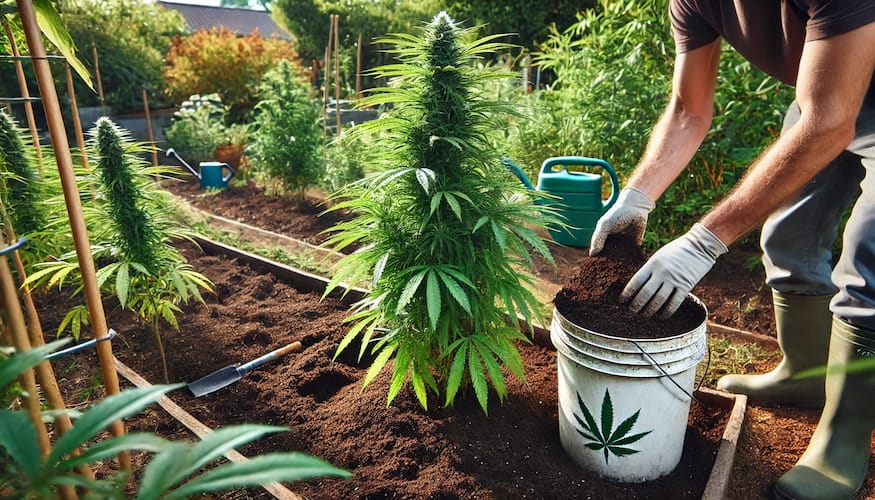
Materials for Top Dressing Cannabis
Selecting the right materials for top dressing is crucial for achieving the desired results. Here are some commonly used dry amendments for top dressing cannabis plants:
Organic Materials
- Compost: Rich in essential nutrients and beneficial microorganisms, compost is a staple for organic top dressing. It improves soil structure and fertility.
- Worm Castings: Often referred to as “black gold,” worm castings are an excellent source of nutrients and beneficial bacteria. They enhance soil structure and water retention.
- Manure: Aged manure from animals like cows, chickens, or horses can be used for top dressing. It provides a rich source of nutrients but should be well-composted to avoid burning the plants.
- Bone Meal: High in phosphorus, bone meal is ideal for promoting root development and flowering in cannabis plants.
- Blood Meal: Rich in nitrogen, blood meal can boost vegetative growth. It should be used sparingly to avoid nitrogen burn.
- Fish Meal: Fish meal is a great source of nitrogen, phosphorus, and trace minerals. It promotes vigorous growth and improves soil health.
Inorganic Materials
- Rock Dust: Contains a broad spectrum of minerals that can replenish nutrient-depleted soils. It is slow-releasing and promotes overall plant health.
- Perlite and Vermiculite: While not nutrient sources, these materials improve soil aeration and water retention, which can enhance nutrient uptake.
Pre-Made Blends
For growers seeking convenience and balanced nutrition, pre-made blends of dry amendments are an excellent choice. These blends are formulated with a mix of essential nutrients tailored for cannabis cultivation. Some popular brands include:
- Gaia Green: Known for its organic, slow-release nutrients that support healthy plant growth.
- Dr Earth: Offers a variety of organic fertilizer blends enriched with beneficial microbes and mycorrhizae.
- BuildASoil: Provides custom-crafted blends designed specifically for cannabis, promoting robust growth and high yields.
When To Top Dress Cannabis Plants
Timing is crucial when it comes to top dressing. Understanding the different growth stages of cannabis and their nutrient requirements will help you determine the best times to top dress.
Vegetative Stage
During the vegetative stage, cannabis plants require high levels of nitrogen to support rapid leaf and stem growth. Top dressing with nitrogen-rich materials like blood meal, worm castings, or fish meal can be highly beneficial. It is best to apply the amendments at the beginning of this stage and then periodically as needed.
Flowering Stage
As cannabis transitions to the flowering stage, its nutrient requirements shift towards higher levels of phosphorus and potassium. Top dressing with bone meal, rock dust, or specialized flowering nutrient blends can support bud development and increase yields. Apply the top dressing at the onset of flowering and again midway through the flowering period.
How To Top Dress Cannabis Plants: Step-by-Step Guide
Top dressing is a simple process, but attention to detail is essential to ensure your plants receive the maximum benefit. Here’s a step-by-step guide to top dressing cannabis plants:
Step 1: Prepare the Soil
Before applying any top dressing materials, ensure the soil is well-prepared. Gently loosen the top layer of soil to promote better integration of the amendments. This can be done using a small hand rake or garden fork.
Step 2: Choose Your Top Dressing Amendments
Select the appropriate dry amendments based on the current growth stage of your cannabis plants. For example, use nitrogen-rich materials during the vegetative stage and phosphorus-rich materials during flowering.
Step 3: Measure the Amount
Carefully measure the amount of top dressing material to avoid over-application, which can lead to nutrient burn or imbalances. As a general rule, apply a thin layer (about 1/4 to 1/2 inch) of the chosen material evenly across the soil surface.
Step 4: Apply the Top Dressing
Evenly distribute the top dressing material around the base of each plant, ensuring it covers the surface of the soil. Avoid direct contact with the stem to prevent potential issues like stem rot. Work the amendments into the surface of the soil, taking care not to disturb the roots of the plant.
Step 5: Water Thoroughly
After applying the top dressing, water the plants thoroughly to help the nutrients begin to break down and penetrate the soil. This also helps settle the top dressing material into the soil.
Step 6: Monitor and Adjust
Regularly monitor your plants for signs of nutrient deficiencies or excesses. Adjust the top dressing frequency and amendments as needed based on your observations and the plant’s growth stage.
Best Practices for Top Dressing Cannabis Plants
To achieve the best results with top dressing, follow these best practices:
Use High-Quality Amendments
Always use high-quality, well-sourced materials for top dressing. Organic amendments should be free from contaminants and well-composted to avoid introducing pathogens or weed seeds into your soil.
Avoid Over-Application
Over-applying fertilizers can lead to nutrient imbalances and potential plant damage. Stick to recommended application rates and adjust based on your plants’ response.
Combine with Mulching
Mulching can complement top dressing by retaining soil moisture, suppressing weeds, and gradually releasing additional nutrients. Organic mulches like straw, wood chips, or leaf litter work well in combination with top dressing.
Regular Soil Testing
Conduct regular soil tests to monitor nutrient levels and soil pH. This information will help you tailor your top dressing approach to meet your plants’ specific needs and avoid over-fertilization.
Monitor Environmental Conditions
Environmental factors like temperature, humidity, and rainfall can affect the efficacy of top dressing. Monitor these conditions and adjust your top dressing schedule accordingly.
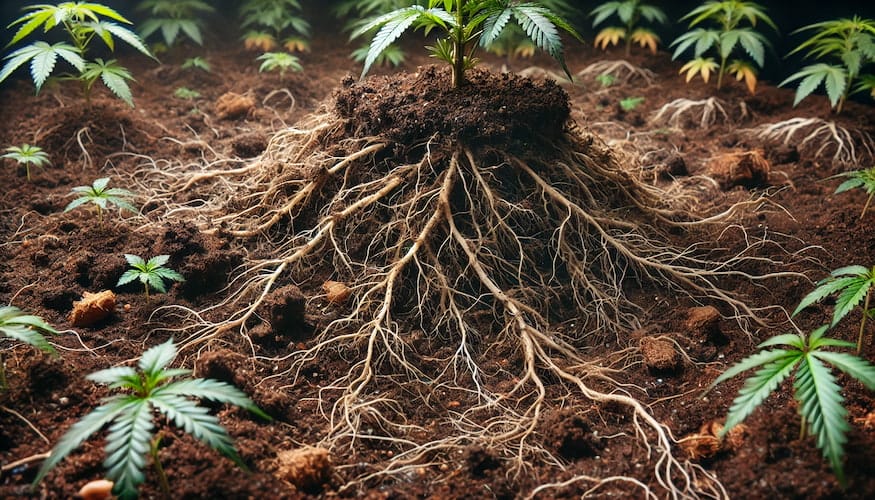
Troubleshooting Common Issues
Even with careful planning, issues can arise during the top dressing process. Here are some common problems and how to address them:
Nutrient Burn
Nutrient burn occurs when plants receive too many nutrients, leading to brown or yellow leaf tips. To prevent this, ensure you are not over-applying top dressing materials and water thoroughly after application.
Pest Infestation
Some top dressing materials, like manure, can attract pests. To mitigate this risk, use well-composted materials and monitor your plants for signs of pest activity. Beneficial insects or organic pest control methods can help manage infestations.
Soil Compaction
Frequent top dressing can sometimes lead to soil compaction, which restricts root growth and water infiltration. To prevent this, regularly aerate the soil and consider incorporating perlite or vermiculite to improve soil structure.
Additional Tips for Successful Top Dressing
Understanding Nutrient Mobility
Different nutrients have varying degrees of mobility within the soil. For example, nitrogen is highly mobile, meaning it can quickly leach away with watering, while phosphorus is less mobile and tends to stay closer to where it was applied. Understanding these differences can help you time your top dressing applications more effectively.
Integrating Organic Teas
Complementing top dressing with organic teas can boost nutrient availability and microbial activity in the soil. Teas made from compost, worm castings, or kelp can provide an additional nutrient boost and improve overall soil health.
Seasonal Considerations
The needs of cannabis plants can vary with the seasons. In outdoor growing environments, consider the local climate and seasonal changes when planning your top dressing schedule. For example, heavier top dressing might be necessary in the spring when plants are entering the vegetative stage.
Balancing Nutrients
Maintaining a balanced nutrient profile is crucial for cannabis plants. Over-focusing on one nutrient at the expense of others can lead to deficiencies. Use a holistic approach to top dressing, ensuring all essential nutrients are supplied in appropriate amounts.
Experimenting with Cover Crops
Cover crops, such as clover or alfalfa, can enhance the benefits of top dressing. These plants fix nitrogen in the soil, improve soil structure, and can be mulched in place to provide additional organic matter and nutrients.
Keeping Records
Keeping detailed records of your top dressing applications, including the materials used, quantities, and timing, can help you refine your approach over time. Tracking plant responses to different top dressing strategies can provide valuable insights for future grows.
Customizing for Strain-Specific Needs
Different cannabis strains may have unique nutrient requirements. Pay attention to how specific strains respond to top dressing and adjust your materials and application rates accordingly to optimize growth and yield.
Top Dressing Cannabis Plants: Conclusion
Top dressing cannabis plants is a valuable technique for growers seeking to optimize plant health and yields. By understanding the benefits, selecting the right materials, and following best practices, you can effectively nourish your cannabis plants throughout their growth cycle. Remember to monitor your plants closely, adjust your approach as needed, and enjoy the rewards of a bountiful harvest.
Now that you know all about top dressing cannabis plants, shop the collection of regular, feminized, and autoflower cannabis seeds at Seeds Here Now.
Back


